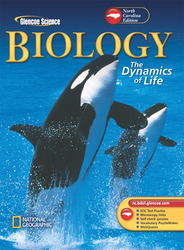Biology: The Dynamics of Life, North Carolina EditionChapter 14:
The History of LifeIn the NewsOld, Cold Dinosaur Discoveries
March 2004
Two separate international groups of scientists exploring Antarctica have discovered two new species of dinosaurs. The two teams were working at separate sites on the world’s southernmost continent, thousands of miles apart from one another. While the work in the extreme climate conditions of Antarctica was challenging, the discoveries are considered even more interesting because they were made within one week of each other. A Dinosaur Found in the Bottom of the Sea
A carnivorous dinosaur, which may have been a theropod, was discovered on James Ross Island in the Weddell Sea, off the Antarctic Peninsula. This area is a landmass close to the southern tip of South America. Paleontologists, scientists who investigate fossils of plants, animals, and other organisms that existed in prehistoric times, believe that this specimen was about 70 million years old. It was estimated that this animal was about 2 meters tall when it was alive. The theropods were dinosaurs that walked on two legs, and included Tyrannosaurs and velociraptors. Current theories believe that theropods may be the ancestors of modern birds. A Dinosaur Found on a Mountaintop
A second research team was exploring Mt. Kirkpatrick, a mountain approximately 3,900 meters high, close to the center of Antarctica near the South Pole. This area was once a soft river bed. They discovered the fossils of an herbivorous dinosaur thought to be about 200 million years old, about two meters tall and perhaps up to nine meters in length. The specimen is thought to be part of the sauropod group, which includes other four-legged dinosaurs such as brachiosaurus and diplodocus. What These Two Discoveries Mean
The researchers involved with both discoveries agree that their data leads them to the conclusion that the two fossil sets found in Antarctica represent two new, distinct species. Researcher William Hammer, of Augustana College in Illinois, who led the team working in the mountains, also stated that since there are only a handful of dinosaur specimens that have been discovered in Antarctica, it is most likely that fossils represent new scientific findings. Activity
Create a diagram that shows dinosaurs that belong to either therapods or sauropods. Include graphics that show what scientists think different species of these prehistoric animals looked like. Based on your research, classify the newly-discovered Antarctic dinosaur with the other species in that group. Resources | 

















